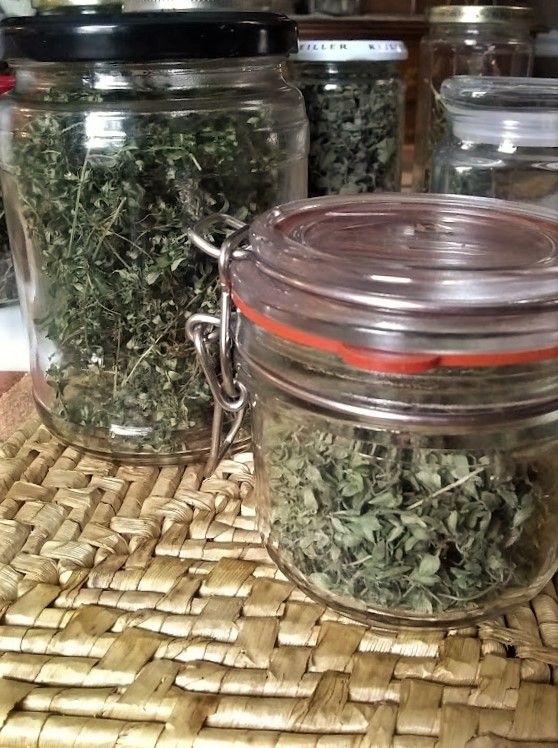It’s Dry!
So here we are. It is early November and my herbs are dry and it’s time to bottle the bounty. My trusty scarecrow, has made his annual pilgrimage to my kitchen table. Also on the table is an array of bottled herbs and some dishes to help me make my Italian herb mix.
I use bottles and jars I have saved throughout the year to store my dried herbs. I have some fancy spice jars on a rack, but they are much to small to hold a season’s bounty. Glass, ceramic or pottery jars are best. I wouldn’t recommend plastic containers or plastic bags. Herbs should be stored in a dry, dark place. It is important that lids fit tightly, keeping unwanted moisture out.
If you want to try to grow your own herbs Back Porch Herb Garden and then dry them It’s Drying Time Again, before you bottle, make sure your herbs are absolutely dry.
Why is dry so important? Mold. Dark, warm place + moisture=Mold (otherwise known as fungus). Moisture in the herb evaporates into the air, but if bottled, that moisture is left to propagate more moisture. Have you ever seen a terrarium? They are a perfect example of this process. Basically, growing plants, soil and all, are covered up entirely with an air tight glass case. You never have to water the plants because the moisture emitted from the soil and the plants, condenses on the glass, and drips the resulting water back onto the garden of plants. That greenhouse effect is great for a terrarium, but not a bottle of herbs.
So without further adieu, let me introduce my crunchy dry herbs

Here’s the gang. This is last year’s crop. The perennials were young. I got substantially more this year, but they are not dry enough for bottling yet. I will let each herb take center stage one by one. Then I will make the Italian herb mix.
Basil

Of course BASIL is first As you can see, it is no longer a vibrant green. Some leaves look more brown than green. The quicker it has been dried, the more green it will be. That is why I suggest cutting large leaves in half or thirds.
Oregano

This is oregano. The bottle in front, on the right, is oregano leaves that dried off the stem. The fatter jar on the left has whole stems that I have broken or bent to fit in that jar. I will use the leaves first and then start taking leaves from the stems I left whole. Oregano has an oval/circular leaf which dries to a greenish grey.
Rosemary

Meet rosemary. There are a couple of branches in the bottle that I have left the leaves on, but most of the leaves that I got from my small plant have been taken off the stems and are laying at the bottom of the jar. They are called leaves of rosemary, but they look just like pine needles and smell very similar also.
Sage

This is sage. Dried, it looks kind of prehistoric. It is brownish grey and the little bumps in the leaves and the furry surface, all work to make this pretty unattractive. But it’s not beauty we are looking for, it is taste. Sage is the herb that is usually most prominent in traditional turkey stuffing.
Thyme

Last, but certainly not least, is thyme. The shorter sealed jar has thyme leaves that have been removed from the stem. They are very small leaves, so a lot of stems and patience, makes for a small yield. The taller, fatter jar in back is thyme still on the stem. Thyme is the most difficult herb to deal with in my small world of herbs. The tiny leaves would take a lifetime to get off, one at a time. The easiest way to strip the leaves off is to swipe your fingers down the stem, against the direction of growth. That breaks the leaves off pretty easily, whether they are fresh or dried. The stems are very thin and woody. They don’t soften up when cooked, so you need to try your best not to add stems to your cooking. Is it worth the trouble? Yes, thyme is a very versatile herb. It is even used in some sweet dishes and beverage. It is a small leaf with a bold flavor.
Ready to make Italian herb mix
Now I am ready to make my annual batch of Italian herb mix. I haven’t used all of the mix I made last year. But, not needing more isn’t going to stop me. Small bottles of mixed homegrown Italian herbs make a great gift for friends and family.
I start by taking a large plate and portioning out the herbs, not using a scale or a measure of any sort. I just eyeball it.
When I first decided I was going to make my own mix, I simply looked at the label on the bottle of mixed Italian herbs I had in my cabinet, to see what was in it. I know what each of the herbs taste like so I know what herbs I want to taste prominent in the mix.

If we look at the dish as the face of a clock, from noon 12 to 3 is oregano. From 3 to 5 is thyme. At 6 is a small handful of rosemary leaves. At 7 is an even smaller amount of sage. And from 8 back to 12 is basil. The basil goes all the way to the middle and makes up almost a full half of the mix. Oregano and thyme make up most of the rest, except for the addition of a little rosemary and sage, which are both strong flavors.
It’s all done except the bottling
I am sure no two batches I’ve made, have been the same. But they have all been great for anything I would use an Italian mix for. It’s not just for spaghetti sauce. It is great in dressings, soups, and stews.
Now the only thing left to do, is mix my herbs together, grind them up a little, get out as many of those pesky wooden thyme stems as I can, and bottle it.
This year’s crop which is not dry yet, has a lot more thyme and sage. So I am going to use them to mix up a traditional herb mix for stuffing.

And here it is, this year’s homegrown
Italian Herb Mix
I BOTTLED SOME UP… JUST FOR YOU


